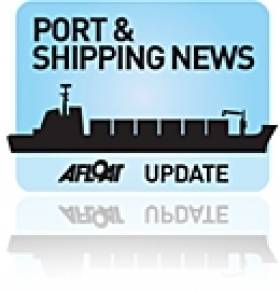Displaying items by tag: Guinness Tanks Cargoship
#GuinnessTankship - The 86m cargsoship Blue Tune (2010/3,845grt) docked in Dun Laoghaire Harbour last night is undertood to have arrived with the final batch of fermentation tanks bound for the Guinness St. James Gate Brewery in central Dublin, writes Jehan Ashmore.
In heavy seas and strong south-easterly gale force winds, Blue Tune made the short passage across the bay from Dublin Port, having firstly delivered a part-cargo from Rotterdam.
Unlike the previous deliveries of the tanks to Dun Laoghaire Harbour taken on board two Dutch-flagged vessels, firstly by Myrte (2008/6,120grt) in February followed by Keizersborg (1996/6,142grt) last month, on this occasion Blue Tune is flagged under Antigua and Bermuda.
In addition Blue Tune is smaller compared to her Dutch counterparts in terms of tonnage size which would also place her as a 'coaster' compared to much larger vessels calling to Dublin Port and in this recent 'project' cargo trade to Dun Laoghaire Harbour.
As with the other Guinness related cargo-calls, Blue Tune berthed at the former 'mail' boat at Carlisle Pier, where six stainless steel fermentation tanks are due to be unloaded within the next few days.
Likewise forward tank transportation from Dun Laoghaire to the brewery which is undergoing a major €153m upgrade, is to be undertaken by road convoy and expected to be carried out in a night-time operation.
Again ‘Tank’ Goodness for Guinness
#GuinnessTanks – More than a week after cargoship Myrte docked in Dun Laoghaire Harbour, the massive fermentation tanks were yesterday transported in a nighttime convoy to the Guinness St. James's Gate Brewery in Dublin, writes Jehan Ashmore.
Another shipment is scheduled to arrive in the harbour towards the end of this weekend and also from Rotterdam. On this occasion, cargoship Keizersborg (1996/6,142grt) operated by Dutch owners Wagonborg Shipping, will be bringing in the second of three batches of the gleaming stainless steel cylinders.
Each of the 30 ton cylinders measure 22m long x 6.6m wide and 5.4m in height and some of them are capable of holding just under 1m pints!
As for the 122m long Myrte (2008/6,120grt) she took the honour as the first commercial vessel, excluding the fastcraft HSS Stena Explorer, to call to the harbour with a consignment of cargo, not seen since the early 1990's.
During that timeframe, the Danish flagged reefer Nordland Saga (1989/2,469grt), which then was a relative newbuild, had also berthed alongside Carlisle Pier.
The vessel registered in Frederickshavn differed to the 'Guinness' project cargo carrying vessels, in that she was fitted with deck-mounted cranes. As such mobile road cranes will again be deployed in the task of unloading the giant tanks onto the Carlisle Pier, where in recent years the former mailboat ferry terminal was demolished.
Carlisle Pier to date has served at times as storage space for yachts and currently has car-parking facilities, yet there are plans to build a landmark Diaspora Centre as part of the harbour's 'master plan'.






























































